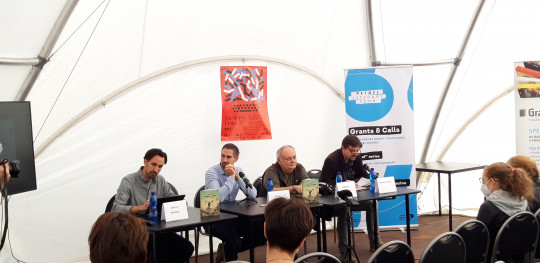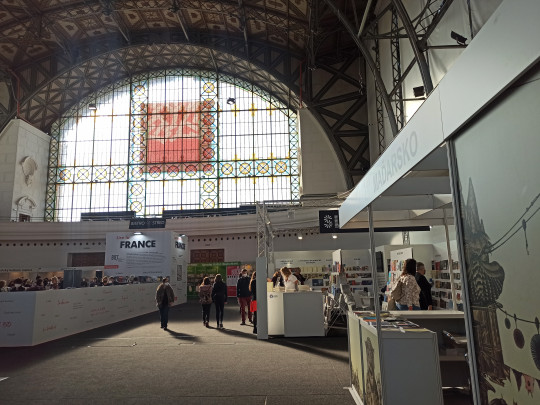From Rácpácegres to Prague
Or how a book fair is born of grotesque masks
At first glance, nothing seems particularly striking or unusual. Everything is very much like yet another book fair. A huge banner on the façade of Prague’s Výstaviště Palace (the Industry Palace) and plenty of food, coffee, and bookstalls outside the building, not to mention outdoor stages for readings. All mark the site of the 2021 Prague Book Fair. Still, both the speakers and the organizers are filled with excitement and relief that, at last, they have managed to pull off something of a small wonder. The first truly international book fair since the pandemic has been a great success, despite everyone’s perfectly understandable fears and anxieties.

Of course, innumerable cautionary measures were taken throughout the book fair, as one could hardly ignore the very real concerns and simply stumble from stand to stand without a mask, thinking that there are no risks, nor should there be (to borrow an echo from the title of the novel There Is None, Nor Let There Be by Hungarian author Edina Szvoren). We are still living in a moment of history when people shudder a bit if they hear someone sneeze nearby. The Prague Book Fair was something of a test of post-quarantine cultural life, including literature, a life in which traditional habits and rituals have been replaced by reflexes and practices which we would previously have considered grotesque. But the revival of cultural life went more smoothly than expected, and visitors, who at last were able to break out of their intellectual isolation for the first time in some eighteen months, were adaptable and accommodating. It was a bit like the drawings by Dávid Remsey in Péter Borbáth’s Sündör és Niru. At first, we are perhaps taken aback by the dark tones of the pictures, but on closer inspection, we see the charming features or gentle gestures in the black lines, and we feel the same sense of warmth that we get when we notice a smile or a look of enthusiasm underneath the otherwise neutral masks worn by visitors to the fair. In an almost magical moment, we forget our initial surprise and take for granted what we had thought absurd.
We have now come to accept and even grown accustomed to the fact that, with the exception of the performers, we all hide our faces behind masks. We have learned to communicate clearly and selectively through the protective layers which conceal our frowns, our smiles. Indeed, we at long last have the chance to get to know our colleagues and the performers, whom earlier we had only known as digital images, blurry squares in video conferences, or email addresses. We can even share a pint of Prague beer with them, and perhaps like characters from the stories by Iván Mándy or Bohumil Hrabal, we may even shake hands with them or, perhaps, throw up after having had one too many.

To paraphrase Péter Borbáth, one finds wonders everywhere, even in a Guatemalan junkyard that inspires you to write a book or at a children’s book launch, where the translator recounts, with a glowing smile on her face, how she fell in love with Hungarian while hitchhiking to Romania. The point is simply that, come pandemic or global lockdown, the wonder of literature must be preserved in a world that can seem increasingly dehumanized, much as the bungling youth from Rácpácegres preserves his Seven-Headed Fairy to this day, to borrow from the title of a classic collection of stories by Hungarian author Ervin Lázár.
(The presentations of the works mentioned in this brief summary were part of the Petőfi Cultural Agency’s program at the Svet Knihy book fair in Prague, which took place between 23-26 September 2021. The works presented: Péter Borbáth: Sündör és Niru, illustrated by Dávid Remsey; Edina Szvoren: Nincs, és ne is legyen, translated by Róbert Svoboda; Iván Mándy: Ciklon; Ervin Lázár: A Hétfejű Tündér)